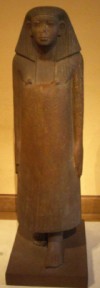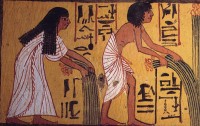Society and Social Hierarchy in Acient Egypt
2 min read
Society in ancient Egypt was organized hierarchically. Pharaoh was on the top of the hierarchical pyramid and an absolute political, jurisdictional, military, administrative and religious power and was considered divine. Egyptian pharaohs ruled alone without consulting with nobility or people and were typical despots, while the form of government was despotism. The title was hereditary although Egyptian ruling houses and dynasties were often overthrown by military commanders, high priests and rival lines which established new ruling dynasties. Pharaohs were viewed as divine or semi-divine and were worshiped like gods. Sometimes they married their sisters to protect the purity of royal blood.

Pharaoh’s orders were carried out by hierarchically organized administration on top of which were the viziers. Viziers were often pharaohs’ sons or members of the royal familes who gave direct orders to the head of royal offices for the army, construction, navigation, trade, medicine, foreign relations, frontiers, tax collecting, crop supply, livestock, and fields. Below the heads of royal offices were the nomarchs, mayors of cities, heads of royal warehouses and livestock, and royal scribes who recorded and collected taxes. Administrative officials had also jurisdictional competences but common people consisting of farmers, merchants, craftsmen, artists and slaves could appeal to the high court or even to the pharaoh himself.
Priests were highly respected members of ancient Egyptian society. They performed religious rituals to gain the goodwill of the gods but they also administered large estates donated by the pharaohs. The largest landowners were the priests of god Amun (Amon-Ra, Amon-Re). The position of a priest was hereditary but priests were also named by pharaohs usually as a reward for special achievements or favors. Priests in ancient Egypt had also several privileges and were free of taxes and military service.

The army was responsible for peace and order within the state and military operations beyond the borders and was organized strictly hierarchically, like the administration and society of ancient Egypt.
Peasants were on the bottom of the social hierarchy and worked on the land which was owned by pharaohs, nobility or temples. Ancient Egyptian peasants were tied to the land but could not be sold. They had to pay taxes and were free of military service but they were obliged to participate in public works such as construction works. However, there were also few independent small landowners who were only obliged to pay taxes. Slaves were on the very bottom of ancient Egyptian society and were mostly prisoners of war. They were personal possession of their owners but they were allowed to marry and have a family. Some slaves even became pharaohs’ retinues and were very influential.
The middle class comprised of craftsmen, merchants, lower officials and artists who were obliged to pay taxes as well as to do military service.